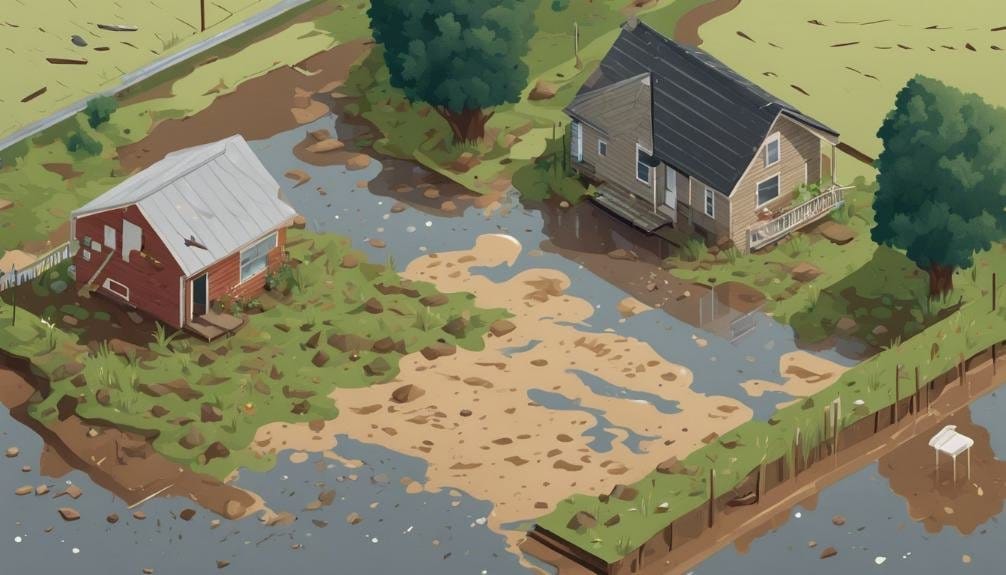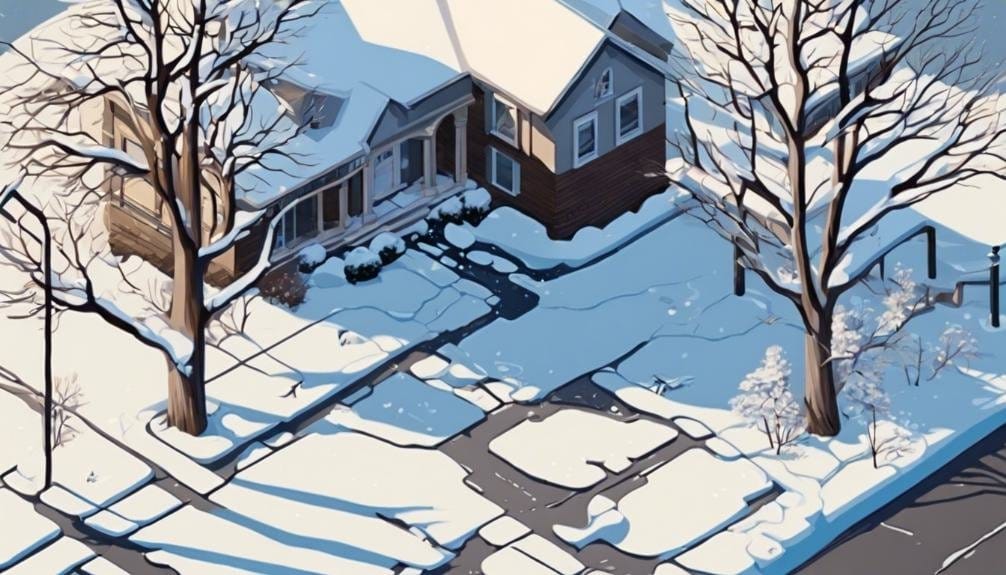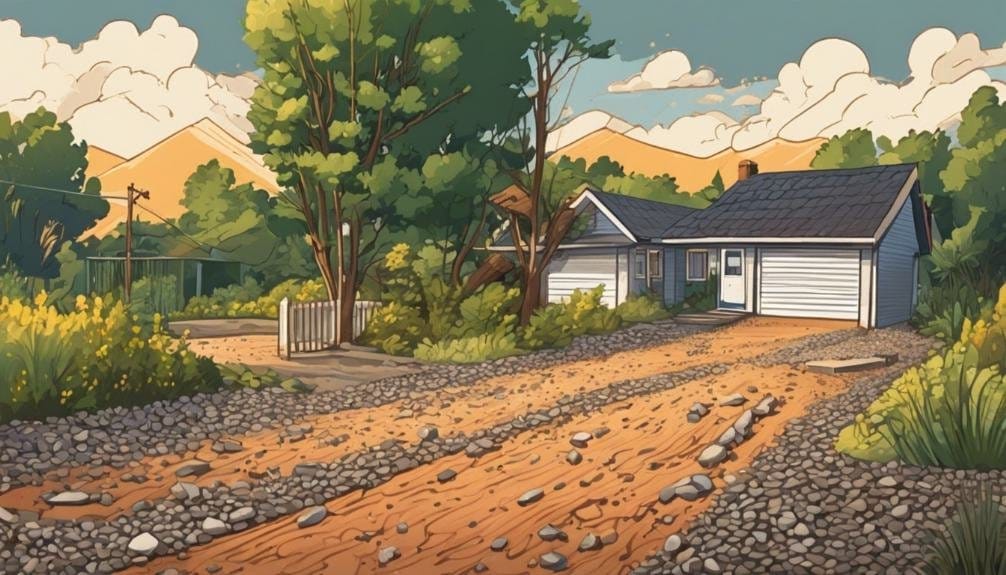Climate change notably impacts your gravel driveway, causing erosion, displacement, and structural issues. Temperature fluctuations lead to gravel instability and potholes due to freeze-thaw cycles. Heavy rainfall can wash away gravel, while flooding exacerbates erosion, demanding robust drainage systems. Drought conditions cause soil compaction and cracking, reducing driveway stability. Mitigate these effects by using temperature-resistant gravel, regrading regularly, and installing efficient drainage like French drains. Ensuring a well-compacted base layer also helps. Additionally, consider permeable pavers for improved durability and reduced maintenance. Discover practical strategies and enhancements to maintain your gravel driveway’s integrity amidst changing weather patterns.
Key Takeaways
- Heavy rainfall can wash away gravel, leading to erosion and sediment runoff.
- Temperature fluctuations cause erosion and displacement of gravel.
- Flooding increases erosion risks, requiring robust drainage systems.
- Drought conditions lead to soil compaction and cracking, destabilizing driveways.
- Freeze-thaw cycles create potholes and roughen gravel driveways.
Temperature Fluctuations
As temperatures fluctuate due to climate change, gravel-based driveways face increased risks of surface erosion and displacement. When air temperatures swing from extreme highs to lows, the gravel’s stability weakens. This is particularly evident during freeze-thaw cycles, where water trapped in the gravel expands as it freezes and contracts when it thaws. These repeated cycles cause the gravel to shift and erode, creating an uneven surface.
Higher temperatures also exacerbate the problem by accelerating the degradation of the gravel material. As the gravel heats up, it becomes more brittle, losing its structural integrity faster than it would under stable climate conditions. This degradation not only reduces the driveway’s lifespan but also necessitates more frequent resurfacing.
To mitigate these impacts, consider using gravel materials specifically designed to withstand temperature fluctuations. Opt for gravel types with higher density and durability, and maintain proper drainage to minimize water retention. Regular maintenance, such as leveling and compacting the gravel, can also help manage the effects of temperature variations.
Heavy Rainfall
Beyond temperature fluctuations, heavy rainfall poses significant challenges for the stability and maintenance of gravel-based driveways. Climate impacts from increased precipitation can lead to erosion and sediment runoff, compromising both the driveway’s integrity and surrounding water quality.
When heavy rain strikes, it can wash away gravel, creating washouts and puddles that make the driveway less usable and stable.
To mitigate these issues, you’ll need to adopt more frequent maintenance strategies. Regular regrading helps redistribute the gravel and fill in any gaps caused by erosion. Additionally, compacting the gravel periodically can enhance its resilience against heavy downpours. However, these measures require consistent monitoring and effort, as climate change continues to increase the frequency and intensity of rainfall events.
Moreover, managing sediment runoff is essential for protecting local water quality. Installing proper drainage systems or using geotextile fabric beneath the gravel can help minimize sediment displacement during heavy rains. These solutions not only maintain your driveway’s structural integrity but also prevent environmental damage caused by erosion.
Flooding Risks

Flooding risks to gravel-based driveways demand robust drainage planning to prevent erosion and maintain structural integrity. Climate change impacts are intensifying precipitation patterns, leading to more frequent and severe flooding events. As a result, your gravel driveway is highly susceptible to erosion and washouts. Without proper drainage, water can quickly undermine the driveway’s stability, making it uneven and potentially unsafe.
To mitigate these flooding risks, you should focus on effective drainage solutions. Installing French drains or swales can help redirect water away from the driveway, reducing the erosion potential. Additionally, incorporating a well-compacted base layer before laying the gravel is essential. This base layer will provide a stable foundation, ensuring that water doesn’t easily permeate and destabilize the surface.
Climate change impacts necessitate periodic maintenance to adapt to evolving weather patterns. Regular inspection of your driveway for signs of erosion or sediment displacement can help you take timely action, such as replenishing gravel or repairing drainage systems. By proactively addressing these flooding risks, you can greatly extend the lifespan and functionality of your gravel driveway.
Ultimately, understanding and planning for these climate change impacts will help you maintain a durable and reliable gravel-based driveway despite increasing flooding risks.
Drought Effects
Drought conditions can severely compromise the stability and longevity of gravel driveways by causing soil compaction and cracking. When moisture levels drop due to drought, the soil beneath your gravel driveway shrinks, leading to increased compaction. This compaction not only affects the driveway’s structural integrity but also creates cracks that can spread over time.
The lack of moisture makes the gravel more prone to shifting and erosion, requiring frequent maintenance to keep the surface even. As a result of these climate change impacts, you may notice that your driveway becomes uneven, posing safety hazards for vehicles and pedestrians alike.
Additionally, reduced precipitation during droughts increases dust generation from your gravel driveway. This not only diminishes air quality but also contributes to the gradual erosion of the driveway surface.
To mitigate these drought effects, establish proper drainage planning. Adequate drainage will help manage water runoff and minimize erosion when rains do eventually return.
Implementing a maintenance routine that includes regular inspection and replenishment of gravel can also help maintain the driveway’s stability. By understanding these impacts and taking proactive measures, you can extend the lifespan of your gravel driveway even in challenging climate conditions.
Freeze-Thaw Cycles

Freeze-thaw cycles greatly expedite the degradation of gravel driveways by causing repeated expansion and contraction, leading to potholes and surface roughening. When water seeps into the gravel during warmer periods, it later freezes and expands as temperatures drop. This expansion forces gravel particles apart, creating voids and displacing material, which weakens the driveway structure over time.
Climate change is exacerbating this issue by increasing the frequency and intensity of freeze-thaw cycles. Regions that previously experienced stable winter temperatures now see more fluctuations around the freezing point, causing more frequent cycles of freezing and thawing. This constant shift accelerates the wear and tear of your gravel driveway, making it more prone to potholes and uneven surfaces.
Gravel driveways are particularly vulnerable to this kind of damage compared to solid pavement surfaces. The loose composition of gravel means it lacks the structural integrity to resist the forces exerted by freeze-thaw cycles. Consequently, you’ll notice more rapid deterioration and a greater need for maintenance.
Proper drainage is essential to mitigate this issue, but without it, the impact of these cycles will be more severe, leading to a shorter lifespan for your driveway.
Maintenance Solutions
Implementing regular grading and leveling of your gravel driveway can greatly mitigate erosion and sediment runoff, ensuring a more stable and durable surface. By addressing minor irregularities promptly, you minimize the risk of larger issues developing due to climate impacts. Heavy rainfall and shifting snow patterns can exacerbate these problems, making timely maintenance essential.
To further protect your driveway, consider installing proper drainage solutions such as culverts and ditches. These elements can effectively channel excess water away from your driveway, reducing the impact of heavy rainfall and potential flooding.
Another valuable addition is stabilizing agents like geotextiles or grid systems. These materials enhance the structural integrity of your driveway, making it more resilient to the changing climate conditions.
Planting vegetation along the edges of your driveway serves as a natural barrier against erosion and helps improve water infiltration. This strategy not only stabilizes the soil but also contributes to the ecosystem.
Lastly, opting for eco-friendly gravel alternatives, such as recycled materials or permeable pavers, can further mitigate environmental impact. These materials improve water quality and manage runoff more effectively, ensuring your gravel driveway remains functional and sustainable despite the evolving climate challenges.
Conclusion
To sum up, climate change disrupts the maintenance of gravel-based driveways. Temperature fluctuations and freeze-thaw cycles present structural challenges, while heavy rainfall and flooding risks can wash away your investment.
Drought conditions also contribute to dust and loosening. However, with proactive maintenance solutions like proper grading and drainage systems, you can mitigate these impacts.
Stay ahead of the game; a stitch in time saves nine, ensuring your driveway remains durable and functional.
Central PA Homeowners: Safeguard Your Gravel Driveway!
The ever-changing weather patterns in Central PA demand proactive driveway maintenance. Avoid the pitfalls of climate-induced wear and tear by consulting Nathan Paving for a free quote. Our skilled professionals provide tailored solutions to tackle erosion, flooding, and temperature fluctuations.
Request your free quote now! Don’t wait until it’s too late. Whether you need a new driveway installation or driveway extension, we’ve got you covered.

